Key takeaways:
- Microservices architecture allows for independent scaling, improved deployment frequency, and enhanced resilience of applications.
- Key challenges include managing inter-service communication, ensuring data consistency, and complex deployments, necessitating strong monitoring and team coordination.
- Effective communication practices, robust API documentation, and regular feedback loops are essential for successful microservices implementation and collaboration among teams.
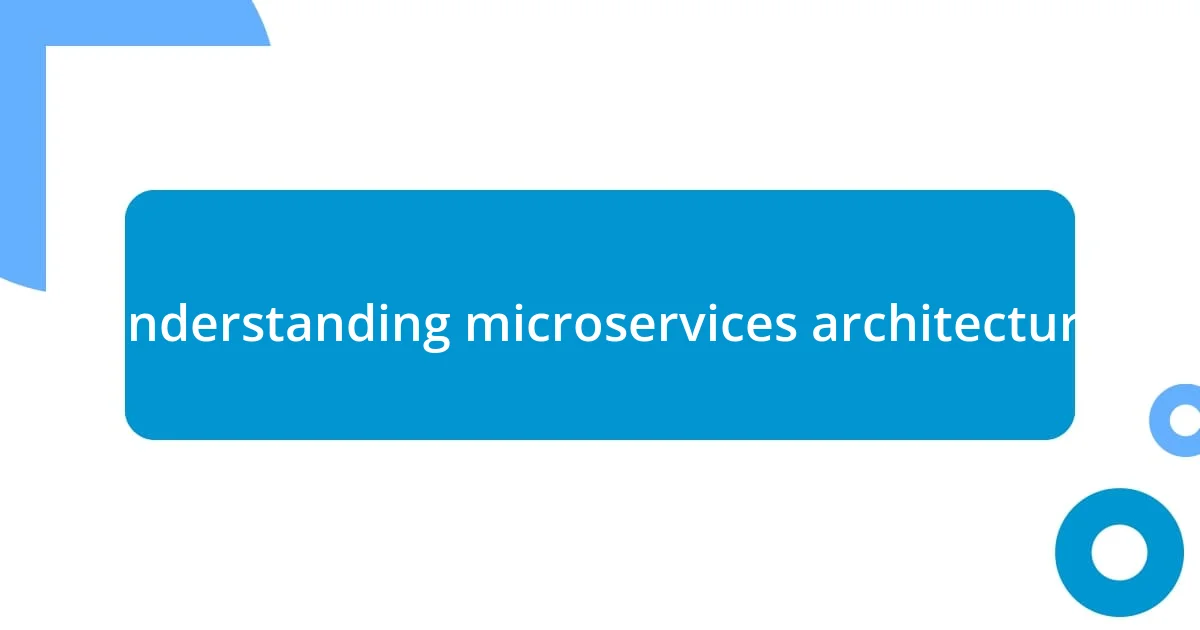
Understanding microservices architecture
Microservices architecture fundamentally changes how we build and scale applications. Instead of a monolithic approach where everything is tightly packed together, microservices break functionality into smaller, independent services. This modularity allows teams to develop, deploy, and scale services separately, which is incredibly empowering. I remember working on a project where our team had to manage a large e-commerce platform. Transitioning to microservices made it easier to update individual components without affecting the entire system.
I’ve often found that understanding the interactions and dependencies between these microservices can be both fascinating and challenging. It’s like piecing together a puzzle, where each service communicates with others through well-defined APIs. I vividly recall a situation where a small change in one service unexpectedly triggered a cascade of issues in others. It highlighted the importance of having robust monitoring and logging practices to quickly pinpoint and resolve problems.
The beauty of microservices also lies in technology diversity; you’re not bound to one stack. Have you ever thought about the flexibility this brings? You can pick the best tools for each microservice’s needs, fostering innovation and speed. However, that freedom comes with its challenges, too. Balancing the need for standardization while encouraging diverse tech choices can be a tightrope walk—I’ve experienced both the exhilaration and the confusion that comes from that dynamic.
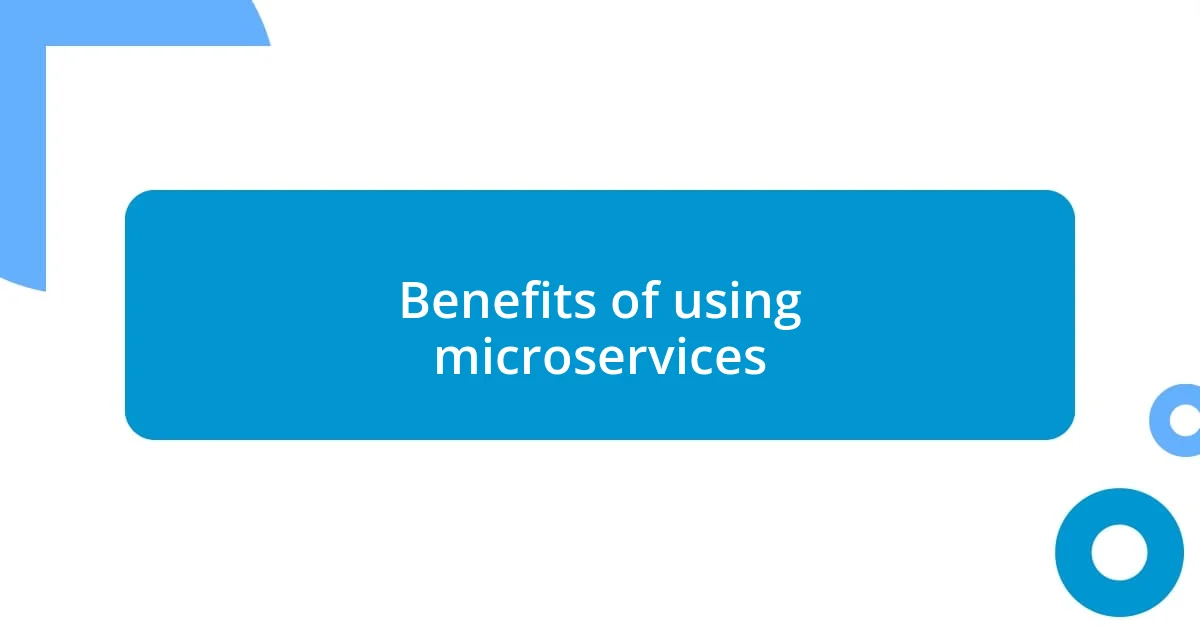
Benefits of using microservices
The benefits of using microservices are manifold, and one stands out to me: scalability. When I was part of a team developing a financial application, we divided the application into distinct microservices, each responsible for a specific function like user authentication and transaction processing. This approach enabled us to scale those services independently. Imagine the relief when our user base skyrocketed, and we only needed to upsize the transaction service without touching the others!
Another advantage I’ve experienced firsthand is improved deployment frequency. In a previous role, we adopted microservices, which resulted in our team deploying code updates weekly instead of monthly. This agility not only kept our users happy with new features but also fostered a culture of continuous improvement within the team. Have you ever pondered how often your applications get updated? It’s a game-changer when you can introduce enhancements and bug fixes at a much quicker rate.
Finally, I’ve found that microservices enhance resilience. During a particularly intense product launch, a bug caused one microservice to crash. Thankfully, the rest of the application continued to function normally. This incident underscored the power of isolation in microservices. It makes me appreciate how vital it is to maintain system stability while minimizing downtime. The ability to recover quickly from failures has given me confidence in the systems I work with.
| Benefit | Description |
|---|---|
| Scalability | Ability to scale services independently based on demand. |
| Deployment Frequency | Frequent updates lead to faster implementation of new features and fixes. |
| Resilience | Isolation of services enhances system stability and minimizes downtime. |
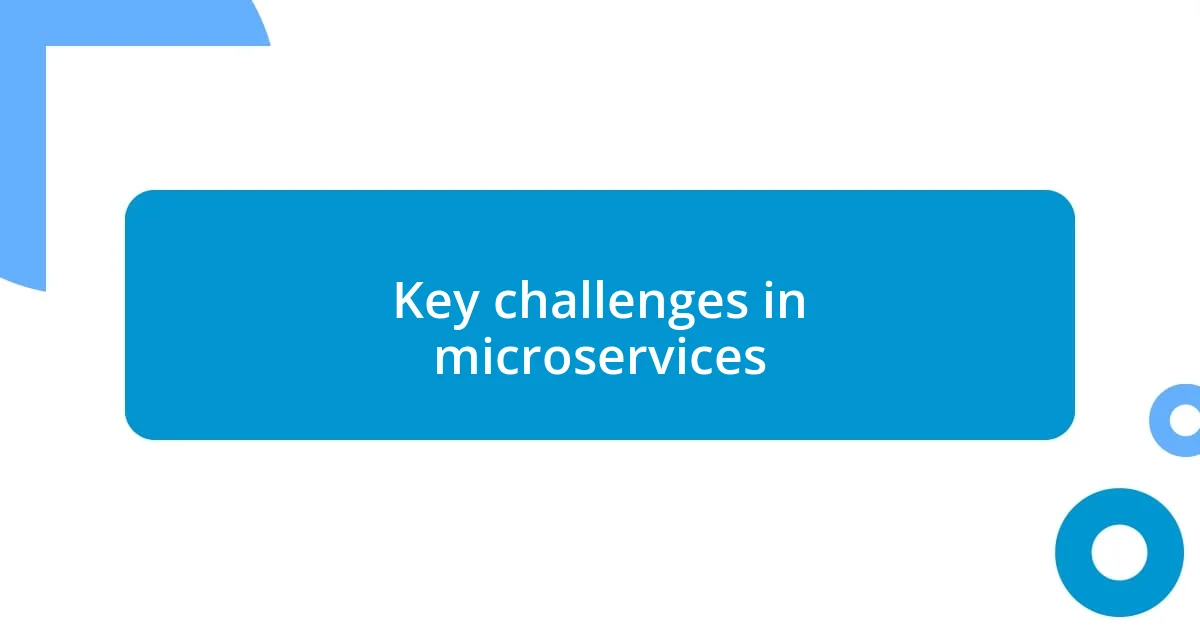
Key challenges in microservices
One of the most significant challenges I’ve encountered with microservices is managing inter-service communication. When I was part of a project where we implemented a microservices approach, the sheer number of services communicating via APIs was overwhelming. At times, it felt like I was juggling too many balls in the air. Ensuring that these services interacted seamlessly required meticulous planning and, honestly, a lot of patience on our part.
While microservices offer incredible flexibility, they can introduce complexities in deployment and orchestration. I remember a specific scenario where a misconfiguration in our orchestration tool led to some services not being deployed, while others rolled out perfectly. We were left troubleshooting late into the night, trying to piece together what went wrong. Here are some key challenges to consider:
- Inter-Service Communication: Ensuring reliable communication can lead to complications, especially with network latency and error handling.
- Data Management: Handling decentralized data can make it difficult to ensure data consistency across microservices.
- Deployment Complexity: The deployment of numerous services increases the risk of errors and coordination challenges.
- Monitoring and Logging: With many moving parts, tracing issues and monitoring performance requires sophisticated tools.
- Team Coordination: Developing microservices often necessitates more collaboration, which can complicate workflows if not managed correctly.
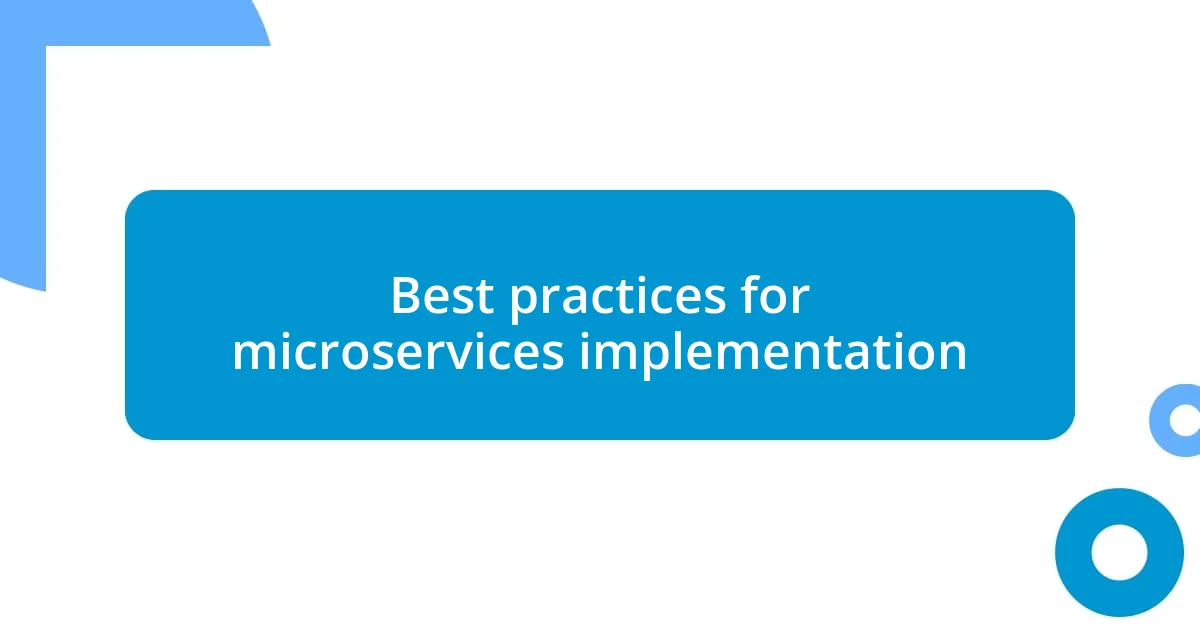
Best practices for microservices implementation
When implementing microservices, I firmly believe in starting with a clear service design. This means thoroughly understanding the business domains and workflows at play. I recall a project where we spent ample time mapping out each service’s responsibilities. It was tedious, but this groundwork ultimately saved us from nightmares later when we had to make adjustments. Think about it: wouldn’t it be frustrating to discover late in development that services were overlapping in their functionalities?
Another critical practice I advocate for is establishing strong communication protocols between services. In my experience, a well-defined API documentation strategy can make or break the interactions among microservices. I once worked on a team where poor API specs led to all sorts of confusion during integrations. By investing time in creating user-friendly documentation, we alleviated many headaches and began to build a more cohesive development culture. After all, wouldn’t you prefer clarity over chaos in your projects?
Lastly, I can’t stress enough the importance of automated testing in a microservices architecture. Embracing a robust testing strategy has been incredibly rewarding for my teams. I remember a pivotal moment when automated tests helped us pinpoint an issue in one of our services before it made it to production. The relief was palpable! Implementing unit and integration tests not only boosts confidence but also encourages a culture of accountability among developers. So, are you ready to embrace testing as a fundamental practice in your microservices journey?
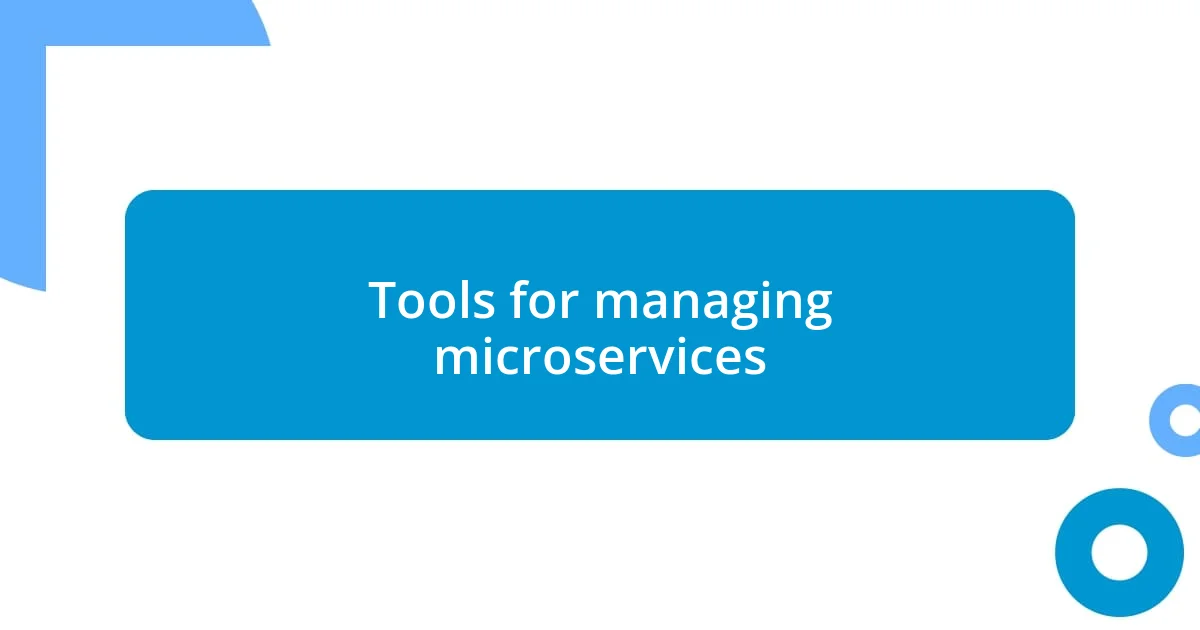
Tools for managing microservices
When managing microservices, the right tools can significantly streamline your workflow. I recall using Kubernetes for orchestration during a big project, and it was like having a skilled conductor managing an orchestra. It effortlessly handled the complexity of container deployments, letting us focus on building features rather than getting bogged down in deployment woes. Have you ever felt overwhelmed by the intricacies of orchestration? Having a tool that simplifies this can make a world of difference.
Another tool that I found invaluable is API Gateway. In one project, implementing an API Gateway helped us unify access to our services and provided an extra layer of security. Plus, it simplified error handling, which meant fewer late-night fire drills for our team. Isn’t it incredible how a single tool can eliminate so much friction? I can’t emphasize enough how essential it is to have a tool that can manage requests efficiently and allow you to monitor performance metrics seamlessly.
Monitoring and logging tools like Prometheus and Grafana have also been crucial to my experience. I vividly remember when an elusive bug caused a service to crash unexpectedly. With the help of these tools, we traced the issue to a specific request pattern and quickly resolved the problem. Isn’t that feeling of clarity and control amazing? Utilizing robust monitoring solutions not only enhances your ability to troubleshoot but also ensures your services run smoothly, contributing to a better overall experience for users.
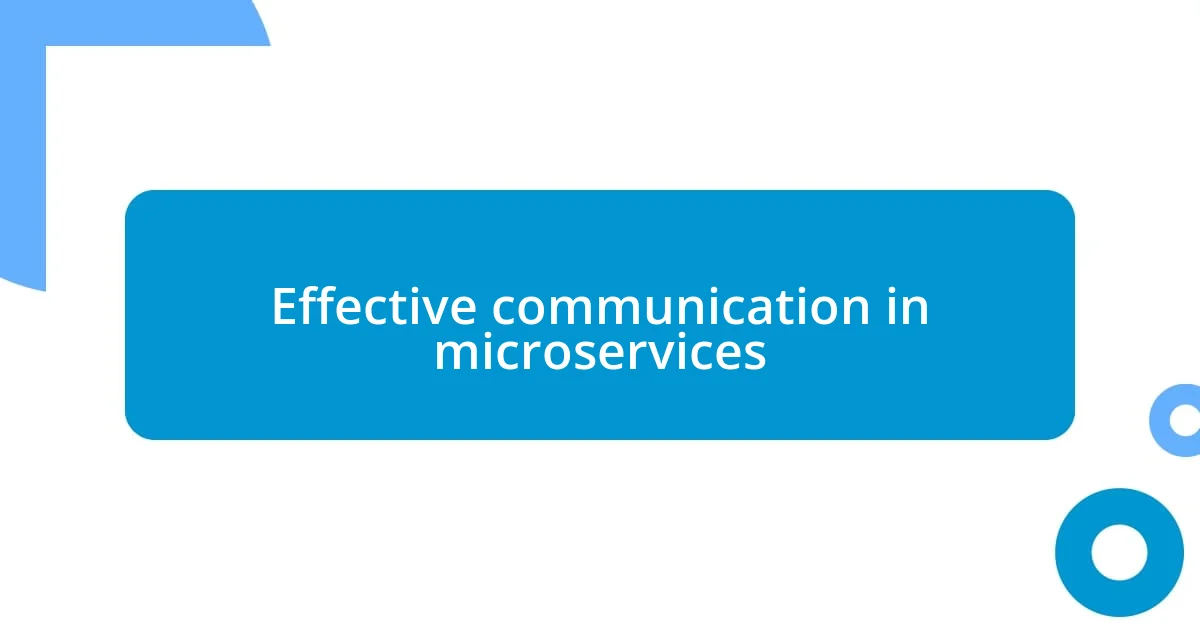
Effective communication in microservices
Effective communication among microservices is not just beneficial; it’s essential. In my journey, I’ve realized that adopting lightweight protocols like REST or gRPC can significantly enhance service interactions. I once tackled a challenge where switching to gRPC reduced latency, making our system feel much more responsive. It was a game-changer; have you ever experienced a similar shift in performance that left you astounded?
Establishing a robust contract between services can dramatically influence the overall health of a microservices architecture. I remember a project where we utilized Swagger for API documentation, and the clarity it brought was palpable. Team members were no longer guessing how to connect services; instead, they had a clear roadmap. Isn’t it remarkable how a well-defined contract can eliminate confusion and foster collaboration?
Also, I cannot stress the importance of regular sync-ups and feedback loops. In one team I was part of, we initiated bi-weekly meetings to discuss communication challenges and share lessons learned. It may seem basic, but those sessions created a strong sense of camaraderie and understanding among developers. Do you think simply talking through issues could enhance the communication flow in your teams too?

Evaluating microservices success metrics
Evaluating success metrics for microservices can sometimes feel like navigating through a maze. From my experience, one of the most valuable metrics is service performance, which includes response times and error rates. I remember monitoring those metrics on a project where even a slight increase in response time was a red flag for us—it often indicated a deeper issue. Have you ever noticed how a small change in performance can lead to significant user experience impacts? It’s crucial to stay vigilant.
Another important aspect is deployment frequency. A high deployment rate usually reflects a mature microservices architecture that promotes agility. In one project, we aimed for daily deployments, and as those rolled out smoothly, it created an exhilarating sense of accomplishment in the team. It’s fascinating how tracking deployment frequency can invigorate the development process and encourage continuous improvement, don’t you think?
Finally, user satisfaction metrics can be compelling indicators of success. I recall gathering user feedback after rolling out a new microservice feature, where the positive responses motivated the entire team. Seeing real users benefit from our work was incredibly rewarding. How often do we remember to connect our technical work back to its impact on end-users? It’s essential to view our success through the lens of user experience to ensure we’re meeting their needs effectively.













